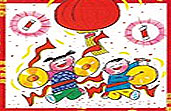 |
| Spring Festival |

China's traditional festivals have evolved through the centuries from past major events. For instance, long ago when people had a bountiful harvest, they gathered and celebrated their good fortune with gala performances. When natural disasters struck, they offered sacrifices to the gods and their ancestors, hoping for a blessing. The change of the seasons, flowers in spring, and the bright moon in autumn could all arouse their longing for a more beautiful life. Thus, creative activities were held to signify these events, Gradually these activities developed into festivals.
The most important festival in China is the Spring Festival. It is said that the Spring Festival evolved from an activity known as the Winter Sacrifice. It was a custom practiced by the people of primitive society.
As the cold winter began to recede and the warm spring was about to begin, the people of an entire clan gathered together. They brought out their bounty from hunting, fishing and the field. They thanked the gods for the blessings of nature, including the mountains, rivers, the sun, moon and stars, They thanked their ancestors, Then they shared and enjoyed the sumptuous bounty of land, sea, air and fields as they ate, danced and sang heartily.
In the beginning, their activity had no fixed date. But usually it was held at the end of each winter. Gradually, through the years, it was celebrated at the end of the old year or the beginning of the new. With the changes and disintegration of primitive society, the form and content of the Winter Sacrifice also changed. Ultimately, it became a festival to bid farewell to the old year and welcome in the new year. So it came to be called the Spring Festival.
All the traditional festivals in China are based on the Chinese lunar calendar. The Spring Festival marks the beginning of the Chinese Lunar New Year. In Chinese, we also say Guo Nian, meaning keeping off the monster of Nian.
|
|
|













